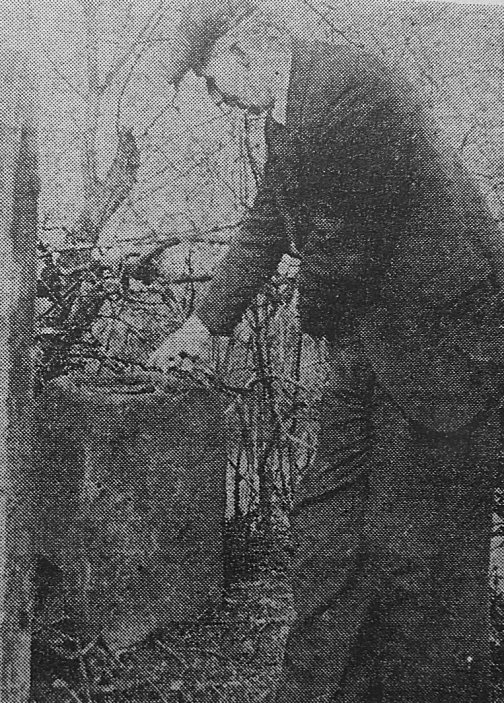South Yorkshire Times June 7, 1958
Darfield Rector Was A Victim
When the Black Plague Visited Wombwell
Not long ago a plague stone was discovered in a hedgerow at Wentworth. This was evidence enough that this district did not escape the great plague which swept the English countryside at all too frequent intervals in the Middle Ages.
The stone was discovered by the Wombwell historian and naturalist Mr. Joss Hudson, of Cross Milton Street, who has written for the “South Yorkshire Times” the following article based on his investigations into this subject. From the records uncovered by Mr. Hudson it is shown that of 141 priests in the West Riding, one visitation claimed 96, among them a Rector of Dartield.
“Wombwell has been smitten at various times by the plague but the worst experienced was that of 1348, described by a Chronicler of that period as follows:
‘In the month of July between the feasts of St. Benedict and St. Swithin, out of the East there came a monstrous cloud, piled and heavy with evil. The leaves drooped on the trees and the birds ceased to sing. All eyes were upon the strange cloud which rolled upwards and onwards. The terror-stricken people crept into the churches and were blessed by the trembling priests, then the rain began to fall. All day it rained and all the night, and all the week and all the month. Forgotten was the blue heaven and the sunshine. The same thick cloud kept on flowing from East to West. It was raining at Lammerstide, raining at the Feast of the Nativity and still rain at Michaelmas.
The crops sodden and and black rotted in the fields. The rain ceased at last. Wet and rotten leaves reeked under the foul haze which rose from the woods. The fields were strewn with monstrous fungi of large size and colour never matched before. And with that musty crop death sprang from the rain-sodden earth
Spared No-One.
`The plague played havoc in the West Riding and spared no-one. Ninety six priests out of 141 died The abbeys and priories were nearly de-populated and churches were closed for want of ministers. All through the winter the dead rotted by the wayside for want of someone to bury them. In many a village not a single man was left alive It spared no-one, not even the baron in his castle. Among the poorer classes the deaths were still more numerous in proportion to the deaths among the upper
classes It was at its worst in 1350. Wombwell was hit heavily, we are told, was and one of the gentry of the period Thomas Allott of Wombwell was buried with it at Darfield”
Wombwell suffered again in the plague which swept the district in the year 1585 One of the victims was Bishop May, Rector oo Darfield.
John May, Rector of Darfield was one of the most learned men of the day and greatly devoted to his duties. He had been the Master of Catherine Hall. Cambridge, and Vice Chancellor of that University, besides being prebend of Ely Cathedral. Nine years after his appointment as Rector of Darfield he was ceated Bishop of Carlisle. The Bishop was compelled to retain his living at Darfield, as during some of those years Lord Scrope, who was watching the borders of Scotland with a large army, was in possession of Rose Castle, the official residence of the Bishop. He did not neglect the See nevertheless. The plague had swept the Wombwell district in 1585 and, moving slowly Northward, it became bad in the border city of Carlisle which lost one, third of its inhabitants in 1597 and among them was Bishop May, Rector of Darfield.
Another Visitation.
Again in 1664-5 the plague paid a visit to the district causing many deaths. In 1665 steps were taken to prevent the spread of the disease. Following is a copy of a document sent with all speed from one constable to another:
‘By virtue of an order from several of His Majesty’s Justices of Peace for this Riding, by means of the continuance of the Plague, which by the immediate hand of God is still continued at London and several places in this Riding, to the danger of the country, it is thought fit, and accordingly ordered not only the ward but also the watch be still continued within this division of the said Riding until upon good cause it be ordered to the contrary, and that the same be performed by every householder in person, or by a sufficient man to that purpose; And if any person refuse or neglect the same, then the constable of each town is hereby ordered to conduct such persons before the next Justices of the Peace to be bound over to the next sessions. And it further ordered that if any householder shall receive any person or persons that come from any infected or suspected place then the constable of each town is not only to secure such person as comes from any infected or suspected place but also such person as shall receive him or her or them and cause the house where they are to be shut up until such time as they shall receive order from the next Justice of Peace for their release.’
This is from an order from the High Constable of the Wapentake of Staincross to the constables of Barnsley, Wombwell and other places.

This is a picture of Mr. Joss Hudson pointing out the plague stone he discovered in a hedgerow at Wentworth.
To avoid contamination, money changing hands was put Into vinegar in the scooped out top of the stone.